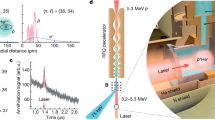Abstract
The ASACUSA collaboration of CERN has carried out two-photon laser spectroscopy of antiprotonic helium atoms using counter-propagating ultraviolet laser beams. This excited some non-linear transitions of the antiproton at the wavelengths λ = 139.8–197.0 nm, in a way that reduced the thermal Doppler broadening of the observed resonances. The resulting narrow spectral lines allowed the measurement of three transition frequencies with fractional precisions of 2.3–5 parts in 109. By comparing these values with three-body QED calculations, the antiproton-to-electron mass ratio was derived as 1836.1526736(23). We briefly review these results.
Similar content being viewed by others
References
Hori, M., Walz, J.: Physics at CERN’s Antiproton Decelerator. Prog. Part. Nucl. Phys. 72, 206 (2013)
Hayano, R.S., Hori, M., Horváth, D., Widmann, E.: Antiprotonic helium and CPT invariance. Rep. Prog. Phys. 70, 1995 (2007)
Yamazaki, T., Morita, N., Hayano, R.S., Widmman, E., Eades, J.: Antiprotonic helium. Phys. Rep. 366, 183 (2002)
Korobov, V.I.: Calculation of transitions between metastable states of antiprotonic helium including relativistic and radiative corrections of order R ∞ α 4. Phys. Rev. A 042506, 77 (2008)
Hori, M., et al.: Sub-ppm laser spectroscopy of antiprotonic helium and a CPT-violating limit on the antiprotonic charge and mass. Phys. Rev. Lett. 093401, 87 (2001)
Hori, M., et al.: Direct measurement of transition frequencies in isolated p̅He+ atoms, and new CPT violation limits on the antiproton charge and mass. Phys. Rev. Lett. 123401, 91 (2003)
Hori, M., et al.: Determination of the antiproton-to-electron mass ratio by precision laser spectroscopy of p̅He+. Phys. Rev. Lett. 243401, 96 (2006)
Parthey, Ch. G., et al.: Improved measurement of the hydrogen 1s-2s transition frequency. Phys. Rev. Lett. 203001, 107 (2011)
Hori, M., Korobov, V.I.: Calculations of transition probabilities and ac Stark shifts in two-photon laser transitions of antiprotonic helium. Phys. Rev. A 062508, 81 (2010)
Hori, M., et al.: Two-photon laser spectroscopy of antiprotonic helium and the antiproton-to-electron mass ratio. Nature 475, 484 (2011)
Hori, M., et al.: Analog Cherenkov detectors used in laser spectroscopy experiment on antiprotonic helium. Nucl. Instrum. Methods Phys. Res. A 496, 102 (2003)
Hori, M., Dax, A.: Chirp-corrected, nanosecond Ti:sapphire laser with 6 MHz linewidth for spectroscopy of antiprotonic helium. Opt. Lett. 34, 1273 (2009)
Udem, T., Holzwarth, R., Hänsch, T.W.: Optical frequency metrology. Nature 416, 233 (2002)
Fendel, P., Bergeson, S.D., Udem, T., Hänsch, T.W.: Two-photon frequency comb spectroscopy of the 6s-8s transition in cesium. Opt. Lett. 32, 701 (2007)
Hori, M.: Photocathode microwire monitor for nondestructive and highly sensitive spatial profile measurements of ultraviolet, x-ray, and charged particle beams. Rev. Sci. Instrum. 113303, 76 (2005)
Korobov, V.I.: Hyperfine structure of metastable states in 3Hep̅. Phys. Rev. A 022509, 73 (2006)
Bakalov, D., Jeziorski, B., Korona, T., Szalewicz, K., Tchoukova, E.: Density shift and broadening of transition lines in antiprotonic helium. Phys. Rev. Lett. 84, 235 (2000)
Mohr, P.J., Taylor, B.N., Newell, D.B.: CODATA recommended values of the fundamental constants: 2006. Rev. Mod. Phys. 80, 633 (2008)
Farnham, D.L., Van Dyck, R.S. Jr., Schwinberg, P.B.: Determination of the electron?s atomic mass and the proton/electron mass ratio via Penning trap mass spectroscopy. Phys. Rev. Lett. 75, 3598 (1995)
Beier, T., et al.: New determination of the electron’s mass. Phys. Rev. Lett. 011603, 88 (2002)
Verdú, J., et al.: Electronic g factor of hydrogenlike oxygen 16O7+. Phys. Rev. Lett. 093002, 92 (2004)
Hughes, R.J., Deutch, B.I.: Electric charges of positrons and antiprotons. Phys. Rev. Lett. 69, 578–581 (1992)
Nakamura, K., et al.: Review of particle physics. J. Phys. 075021, G37 (2010)
Gabrielse, G., et al.: Precision mass spectroscopy of the antiproton and proton using simultaneously trapped particles. Phys. Rev. Lett. 82, 3198 (1999)
Thompson, J.K., Rainville, S., Pritchard, D.E.: Cyclotron frequency shifts arising from polarization forces. Nature 430, 58 (2004)
Author information
Authors and Affiliations
Corresponding author
Additional information
Proceedings of the 9th International Workshop on Application of Lasers and Storage Devices in Atomic Nuclei Research “Recent Achievements and Future Prospects” (LASER 2013) held in Poznan, Poland, 13-16 May, 2013
Rights and permissions
About this article
Cite this article
Hori, M. Two photon laser spectroscopy of antiprotonic helium atoms at CERN’s AD. Hyperfine Interact 227, 17–22 (2014). https://doi.org/10.1007/s10751-014-1022-y
Published:
Issue Date:
DOI: https://doi.org/10.1007/s10751-014-1022-y



